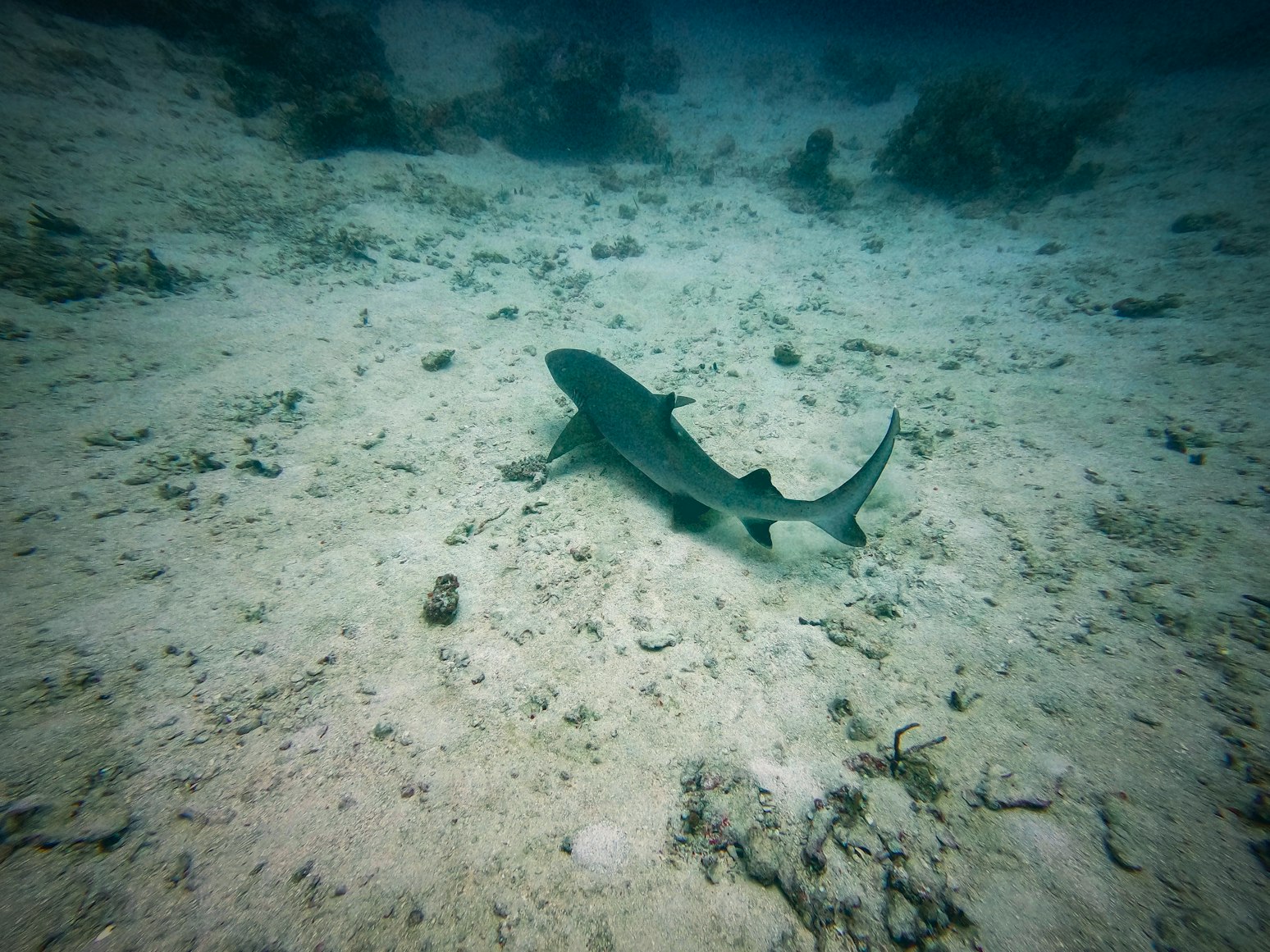The three idyllic Gili islands are ringed by fabulous coral reefs, making them a perfect destination for diving, especially for beginners wanting to learn to dive while on holiday or honeymoon.
There are more than twenty dive sites around the islands, ranging from shallow reefs near the beaches suitable for novices to deep dives in strong currents for advanced divers, taking in shipwrecks, sea mounds, walls, coral gardens and an astonishing amount of marine life and biodiversity. This includes guaranteed turtles, as well as a wide array of tropical reef fish such as scorpionfish, angelfish and lionfish, and also moray eels, stingrays, cuttlefish and octopuses, mantis shrimp, lobsters, manta rays and reef sharks.
The water is always warm, averaging 28°C, outside of the rainy season the visibility is always high, up to 35 metres at the height of the dry season, and all of the dive sites are easily and quickly accessible from all of the islands – meaning that if you pay for your time diving you will spend most of that time diving and not in the boat.
Drift dives are a speciality of the Gilis, where divers can glide with the current, letting it take them the whole length of the dive site, to find the boat waiting for them at the end. There’s no need to get tired from swimming – just relax, remain buoyant and drift along, marveling at the beautiful corals and sea life. When you want to be picked up, you release a marker buoy and the boat will come for you.
What’s more, all of this is available at a very good price: diving in the Gili Islands is amongst the most affordable in all of South East Asia.
How to get to the Gili Islands with Bluewater Express?
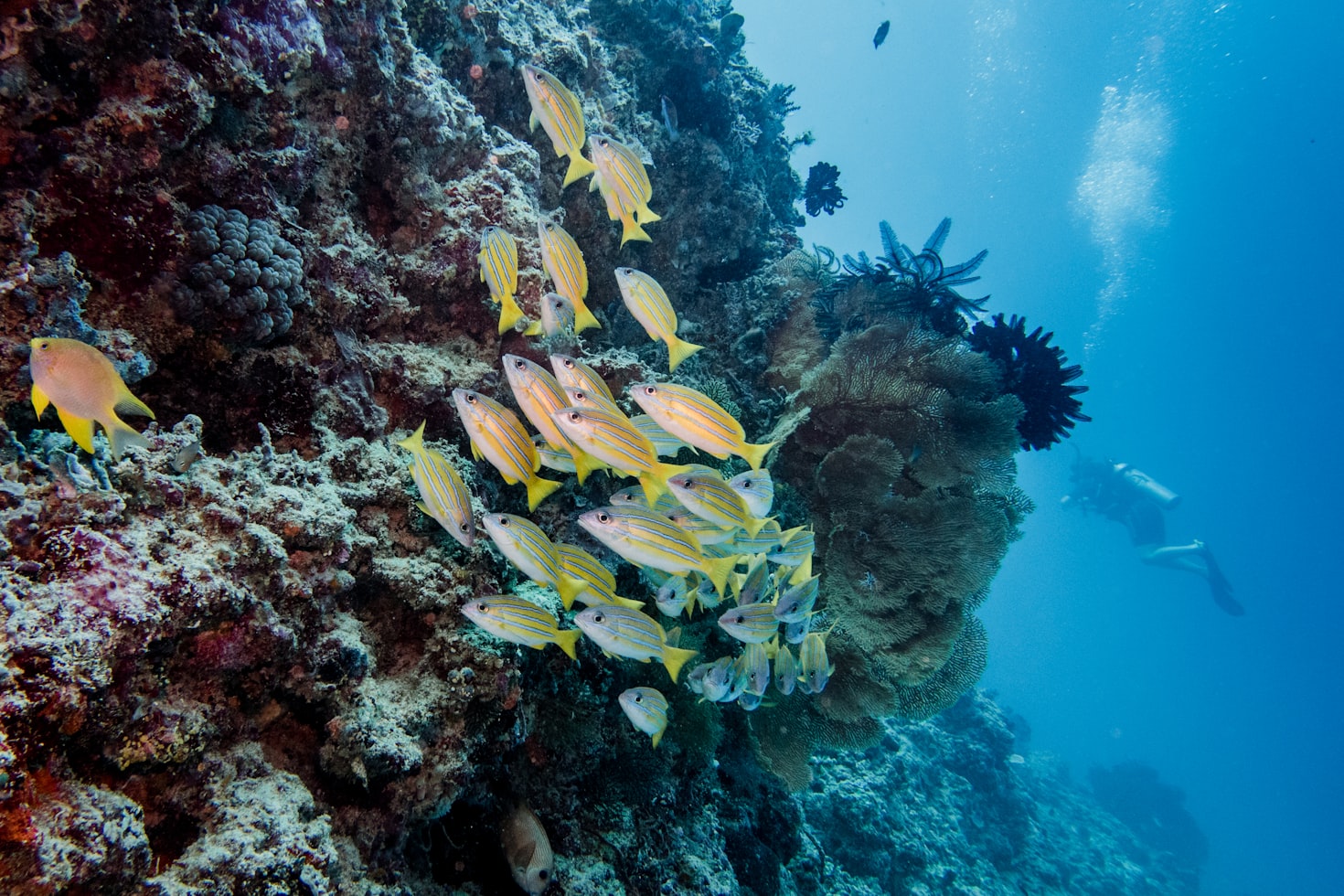
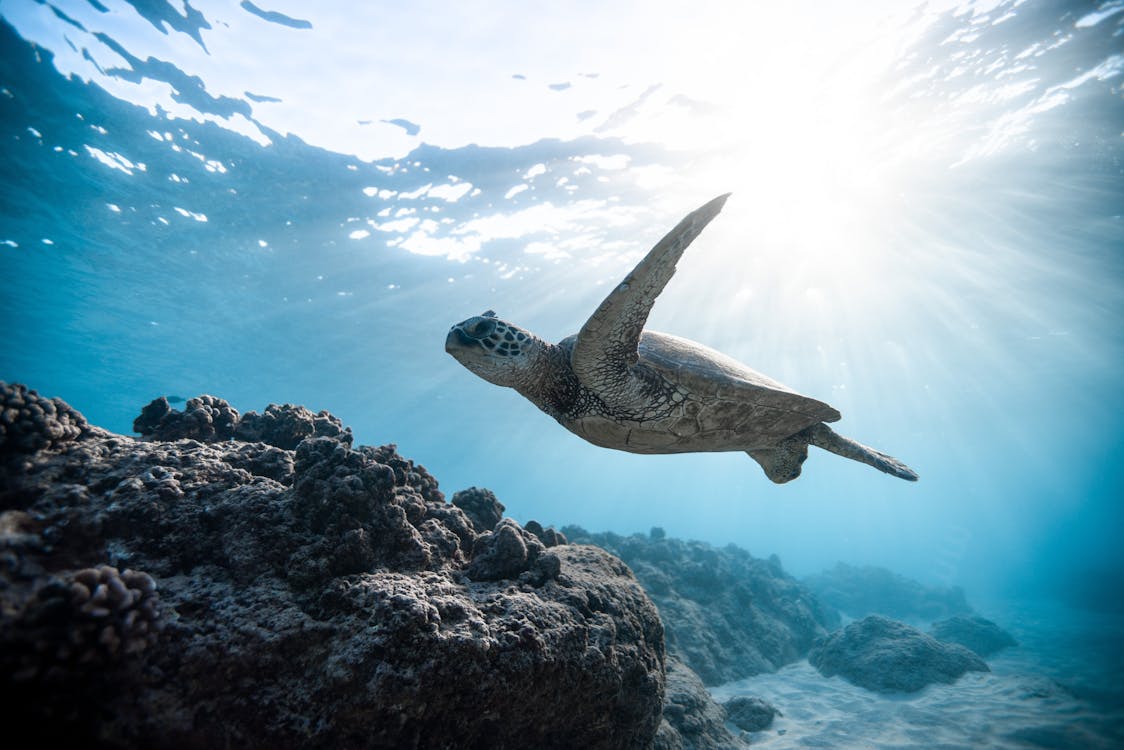
Learn to dive in the Gili Islands
There are a large number of dive schools operating on the islands, enabling first-time divers to complete their Open Water Certification, and take further courses such as deep diving certification. Knowledgeable and qualified dive guides are always available.
All of these dive schools offer the same services, at the same fixed prices; talk to them, look around and choose the people you are happy to spend your diving time with. Each school normally offers up to four dives a day, including sunset dives and night dives; which sites are available each day will be on a sign in front of the dive centre. Most dives last from 45 minutes to an hour.
With more than 20 dive sites available, the schools can offer dives for a range of abilities, including complete beginner. All dives take place with qualified guides, including the advanced dives. Every boat is equipped with oxygen and communication technology, safety standards are rigidly adhered to, and safe drinking water is always available.
As a beginner on your first dive, you will be shown how to prepare and use your diving gear, and then you will be carefully guided when underwater. You will be in a group of no more than five novice divers, all under the supervision of qualified instructors.
For those who have dived before, or who want to develop their abilities, a wide range of courses and qualifications are available, such as specialist wreck diving courses, all the way up to becoming a dive instructor.
When to go diving in the Gili Islands
As with Bali and Lombok, the Gili Islands experience two distinct seasons, wet and dry. It’s very possible to enjoy a holiday in the Gili Islands in the rainy season, which lasts from the end of November until early April, but it’s not the best time for diving. Water visibility is significantly impacted, and the seas can become rough. It rains hard for several hours each day, and when it’s not raining the humidity is high.
The dry season lasts from April to November, with the busiest tourist season in July and August. To ensure that you can be relaxed and unstressed when diving for the first time, it’s good to avoid the peak season and go in April-May or September-October, when there are fewer crowds but the weather is still great. In July and August it’s better to book in advance, whereas out of peak season you can show up the day before and talk to the instructors about what you are looking for.
Get your diving certification
As a beginner, you can start with an Open Water Certificate. This will normally take no longer than three days, and the prices on the Gili Islands are very affordable. You will start by diving the shallow dive sites, close to the beaches, until you become more confident and experienced.
As well as time learning to dive, firstly in a pool and then in the open water, you will watch videos and read book chapters, and be tested on what you have seen and read. You will then make four underwater dives, and if all goes well, you will receive your Open Water Certificate and be licensed to dive anywhere in the world, down to a depth of 18 metres.
The Open Water Certificate costs $370. Many of the dive schools in the Gili Islands offer their courses in French, Spanish and German as well as English.
For more advanced certification, there are two types of diving qualification, SSI and PADI. They are both governed by the World Recreational Scuba Training Council (or WRSTC), and both offer essentially the same training and instruction, with some small differences in techniques.
Both offer a structured hierarchy of levels and courses, and although some of the names are different, you will receive the same training and expertise from both. By agreement, prices are fixed throughout the different dive schools across the three Gili Islands.
Some recommended diving schools currently operating are:
- Blue Marlin Diving
- Manta Dive
- Big Bubble Diving
- Trawangan Dive
- Dive Central Gili
- Mango Dive
- Villa Ombak Diving Academy
- Dream Divers
- Buddha Dive
- Gangga Divers
Available courses include Digital Underwater Photography, and a range of SSI and PADI courses from beginner to Dive Master and Instructor. Some of these courses are:
- The SSI Scuba Diver course. This is the entry level beginner’s qualification in the SSI hierarchy, and certifies the holder to dive to 12 metres with a qualified guide. The PADI equivalent is the PADI Introduction Dive.
- SSI Advanced Adventurer. This course gives you the opportunity to try out five different specialities, completing one open water training dive per speciality.
- SSI Deep Diving. With both academic sessions and open water dives, this course teaches everything you need to know to be able to dive down to 40 meters.
- SSI React Right. This is the first response course that provides training and knowledge to be able to be a first responder in an emergency.
- PADI Advanced Open Water Diver. This course gives you a suite of new skills, including the ability to dive to 30 meters, improved underwater navigation, and three additional adventure dive specialities.
- PADI Rescue Diver. This teaches self-rescue skills as well as the ability to assist others in distress, and is a very popular course.
Diving in Gili Trawangan
Gili Trawangan is host to the majority of dive schools in the Gili Islands, although they can also be found on the other two islands. In fact, there are more than 15 to choose from. Here are some recommendations:
- Blue Marlin was the first dive school in the Gilis. It’s a PADI 5-Star dive center with a professional emphasis on safety. It’s also a high-tech school that offers such things as mixed gases and rebreathers.
- Trawangan Dive is a big dive school with a party atmosphere. Choose this school if you are looking to make party friends with fellow divers.
- Big Bubble is a medium-sized dive school with a wide range of instructors.
- Mango Dive in the north is a small dive school that offers a personalised experience.
- Dive Central Gili is a mid-sized PADI 5-Star dive school managed by divers who have spent many years living on Gili Trawangan. They offer both fun dives and PADI certificates.
- Manta Dive offers both PADI and SSI courses and certifications. It’s a large school that can accommodate many divers of different skill levels every day.
Gili Trawangan’s Dive Sites
 Manta Point
Manta Point
This is a great site for beginners and one of the most popular in the Gili Islands. It’s the best place in the islands to see Manta Rays, which often swim by in large trains of up to 20 individuals. The site is a gently sloping reef, where the local currents are mild and suitable for all levels. It is a perfect dive for the Open Water Certification, and as it slopes down 30 metres it is also a great spot for the SSI and PADI Deep Water qualifications.
You will also encounter many types of coral, such as staghorn coral with small fishes hiding inside, puffer fish, angelfish, schooling oriental sweetlips, cuttlefish, reef sharks, peacock mantis shrimp, stingrays and octopuses, and of course green and hawksbill turtles. Lined snappers school above the reef, swaying gently in the currents.
Please make sure that you never touch a Manta Ray!
Shark Point
This site is also hugely popular because it routinely offers divers the largest variety of marine life to be seen in a single dive in the Gili Islands. It’s a plateau of coral reef, with sea fans, giant barrel sponges, sea whips and stony corals, starting ten metres deep and sloping to 18 metres – hence it isn’t suitable for beginners, but it’s a great spot for the Advanced Adventurer and Deep Diving Certificates.
You are almost guaranteed to see black tip, white tip and reef sharks here, as well as all the other marine biodiversity that the region is famous for. There are so many turtles to be seen here that it could be named ‘Turtle Point’. The sandy bottom is crossed by deeper canyons where marine invertebrates hide.
Manta rays, giant trevallies, spanish mackerel and dogtooth tuna also visit Shark Point. And if you do a night dive at full moon you will see a huge concentration of bumphead parrot fish.
Halik
This site is divided into Deep Halik and Shallow Halik, the latter being perfect for beginners. It’s a beautiful spot, with a great variety of colourful soft and hard corals. You are likely to see at least five turtles in any one dive, as well as free-swimming morays, cuttlefish and octopuses, butterflyfish, rainbow-colored anthias, red tooth triggerfish and clownfish. Deep Halik is home to pink and orange sea fans, where schooling snappers, white tip reef sharks and blue spotted ribbon-tailed rays can be found. As at Shark Point, if you go at night when it’s full moon you can see schools of bumphead parrot fish.
BioRock
Created by Manta Dive and Gili Eco Trust, Biorock Reef is an artificial structure made from steel platforms that have low-voltage currents passing through them. This allows the fast accretion of calcium carbonate, helping coral reefs to form where they were previously damaged or destroyed, and to better survive bleaching events.

Find out more about BioRock technology in this article about Gili Eco Trust.
Soft corals, sponges, tunicates and bivalves all grow and live on the structures, which are also home to scorpionfish, trumpetfish, butterflyfish, lionfish, triggerfish and damselfish.
Good heart
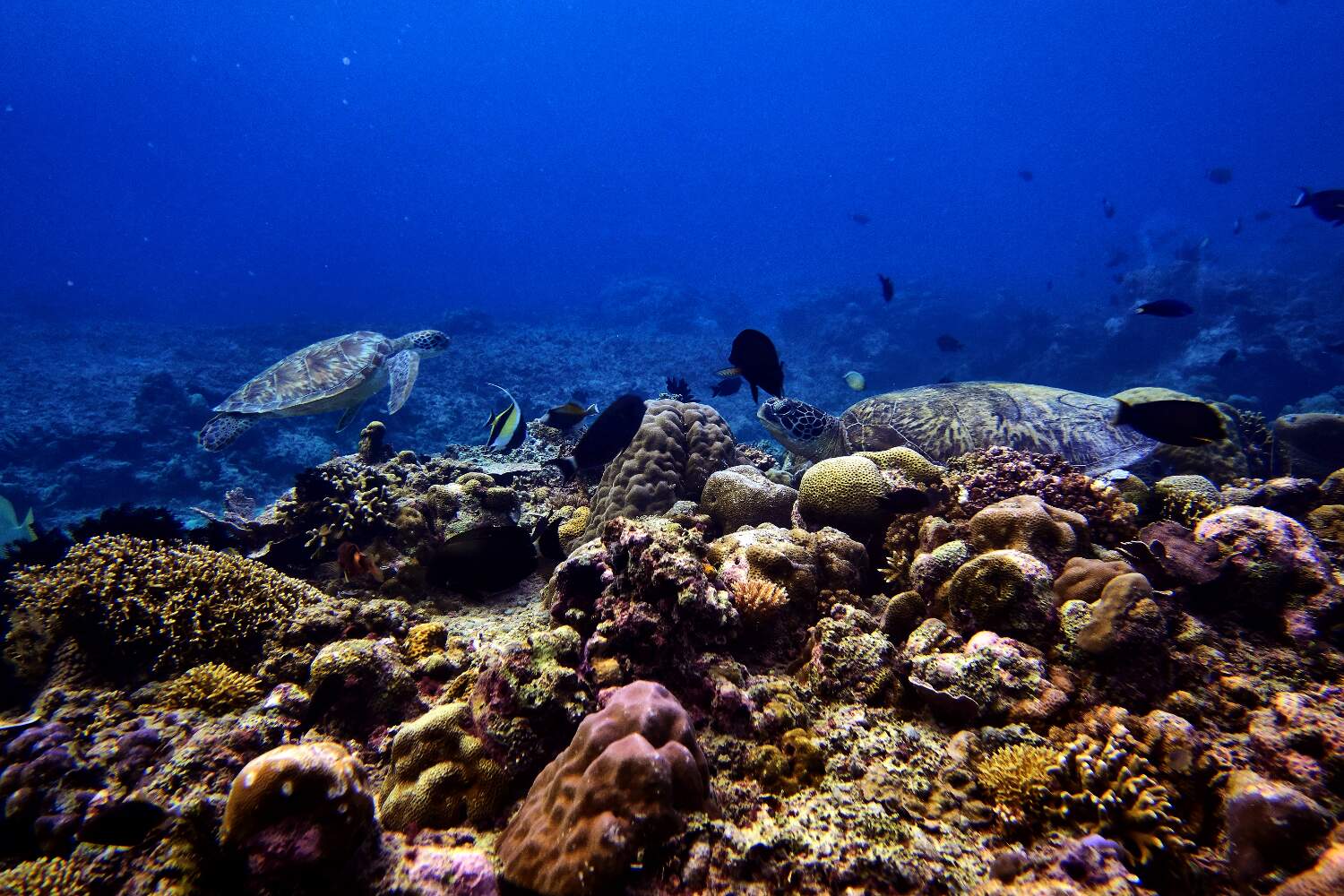
This is the far end of the BioRock artificial reef, with a mild current that is just right for drift diving. It’s a great spot to take your Open Water Certificate. You will see green and hawksbill turtles, soft corals and sponges, angelfish, anemonefish, garden eels, stingrays and shrimp gobies.
Jack Point

The best place in the Gili Islands for pelagic encounters, this is a Deep Dive for advanced divers only. It’s a perfect place to get your Deep Diving Certificate.
Two coral ridges separated by white sand are found 24 metres deep, with fish schooling in between them. You will see big eye trevallies, white and black tip reef sharks, black, lined and humpbacked snappers and occasional devil rays, spotted eagle rays and manta rays.
Deep Turbo
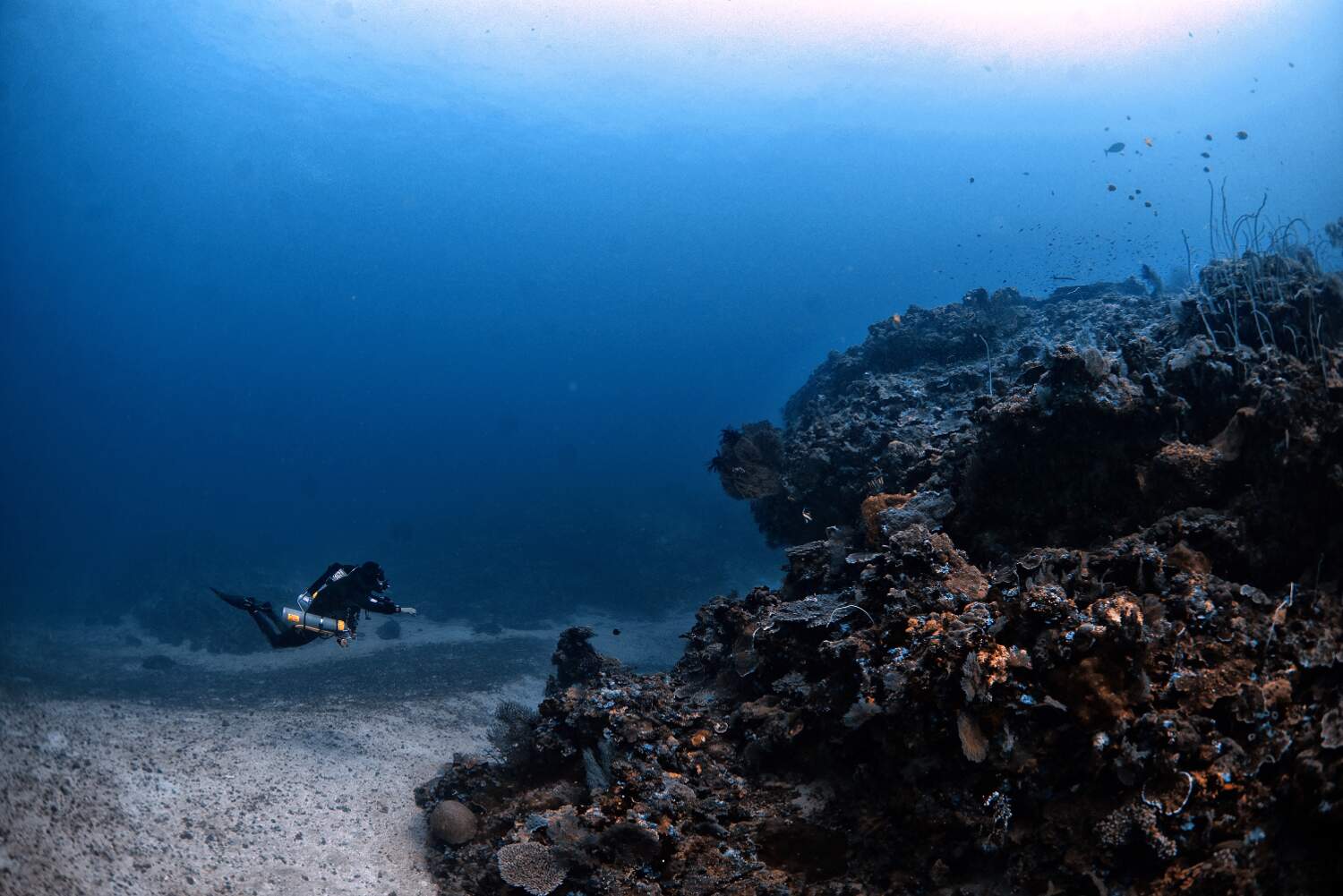
This is another Deep Dive site for advanced divers. Beautiful sea mounds rise from the sandy sea floor 30 metres down, with huge gorgonian sea fans at 20 metres that are home to hiding pygmy seahorses.
Drift from mound to mound along the medium-strength current and you will see garden eels, butterfly fish, batfish and bumphead parrotfish, spotted eagle rays, and the occasional leopard shark passing through.
The Wreck of the Glenn Nusa
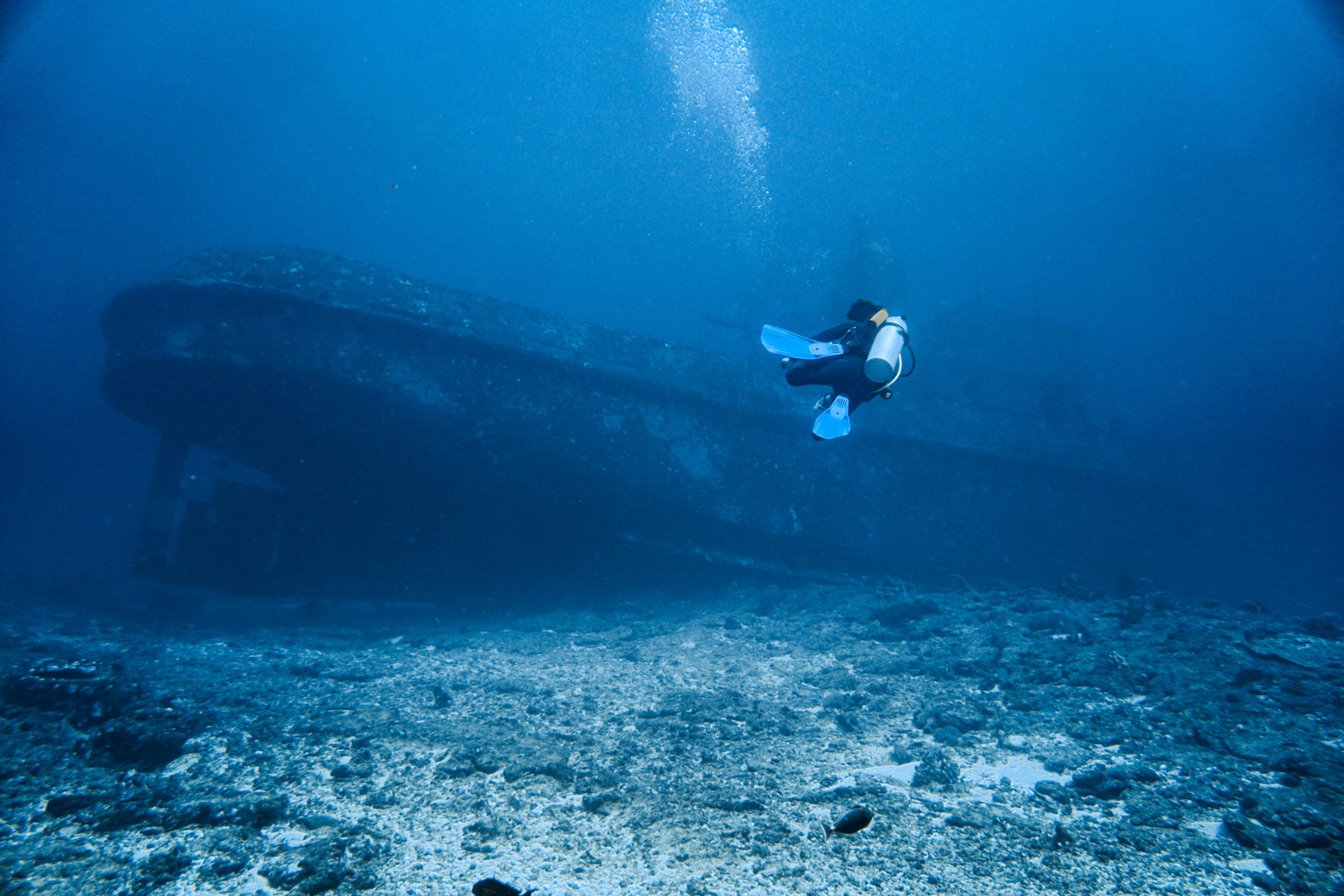
Originally a Lombok tugboat, the Glenn Nusa was bought by the Trawangan dive schools and the Gili Eco Trust and deliberately sunk in February 2016, to make a new habitat for corals and reef fish, and to create a new dive site. Found on a sloping part of the sea floor, the wreck site drops from 22 metres down to 29 metres. This means that it is for advanced divers only, and is a perfect spot to complete the Advanced Adventurer Certificate.
The wreck is slowly transforming into an artificial reef, with more and more coral and marine fauna growing and arriving every month.
When the current is right, you can begin your dive at the Glenn Nusa and then drift along to Shark Point.
How to get to the Gili Trawangan Dive Sites with Bluewater Express
Dive sites in Gili Meno
The dive schools Blue Marlin Dive and Gili Meno Divers both operate on Gili Meno.
The Wreck of the Meno Bounty
The Meno Bounty was a 30-metre-long floating dock that was used by the Bounty Resort on Gili Meno, which sank in a storm in 1999. Colonised by coral trees, leather corals and multicoloured sponges since then it is now a beautiful artificial reef. Sloping down from 8 metres to 18 metres it is suitable for all levels of diving ability.
You will see many species of angelfish in the coral, including blue girdled, masked, emperor, lemon peel and semi-circle, as well as butterflyfish, schooling fusiliers, leaf scorpion fish, frog fish, sea moths, small crabs and rays, and of course green turtles. Blue ringed octopus and giant frogfish will occasionally be seen.
You can drift with the current along the wreck then out to where a coral ridge, with acropora corals and gorgonian sea fans, extends from the wreck down to 20 metres. There you can see pink, false clown, tomato and Clark’s anemonefish.
Both the Open Water and Deep Adventure courses can be taken at the Meno Bounty.
The Meno Slope extends away from the Bounty Wreck, a sandy dive site where green turtles live. You will also see large pufferfish, leaf scorpionfish, several species of anemone fish, multicoloured nudibranchs and spiny lobsters.
Advanced divers can descend to deeper ridges where giant moray eels can be found, as well as schooling snappers and fusiliers. These ridges are surrounded by white sand where you can sometimes see spotted eagle rays.

Turtle Heaven (Marlin Hill)
Suitable for all levels of diving ability, Marlin Hill is possibly the best dive site in the whole Gili Islands area to see turtles. Its nickname is self-explanatory: this large sea mound in crystal-clear waters is home to a large number of green and hawksbill turtles, who can be seen grazing on sponges or getting cleaned by surgeonfish and cleaner wrasses.
You will also see scorpionfish, schooling fusiliers, cornetfish, blubberlip snapper, angelfish, orange, false clown and Clark’s anemone fish, peacock mantis shrimp and octopuses.
More advanced divers can descend to 30 metres, where white tip reef sharks, malabar groupers and eagle rays can be seen.
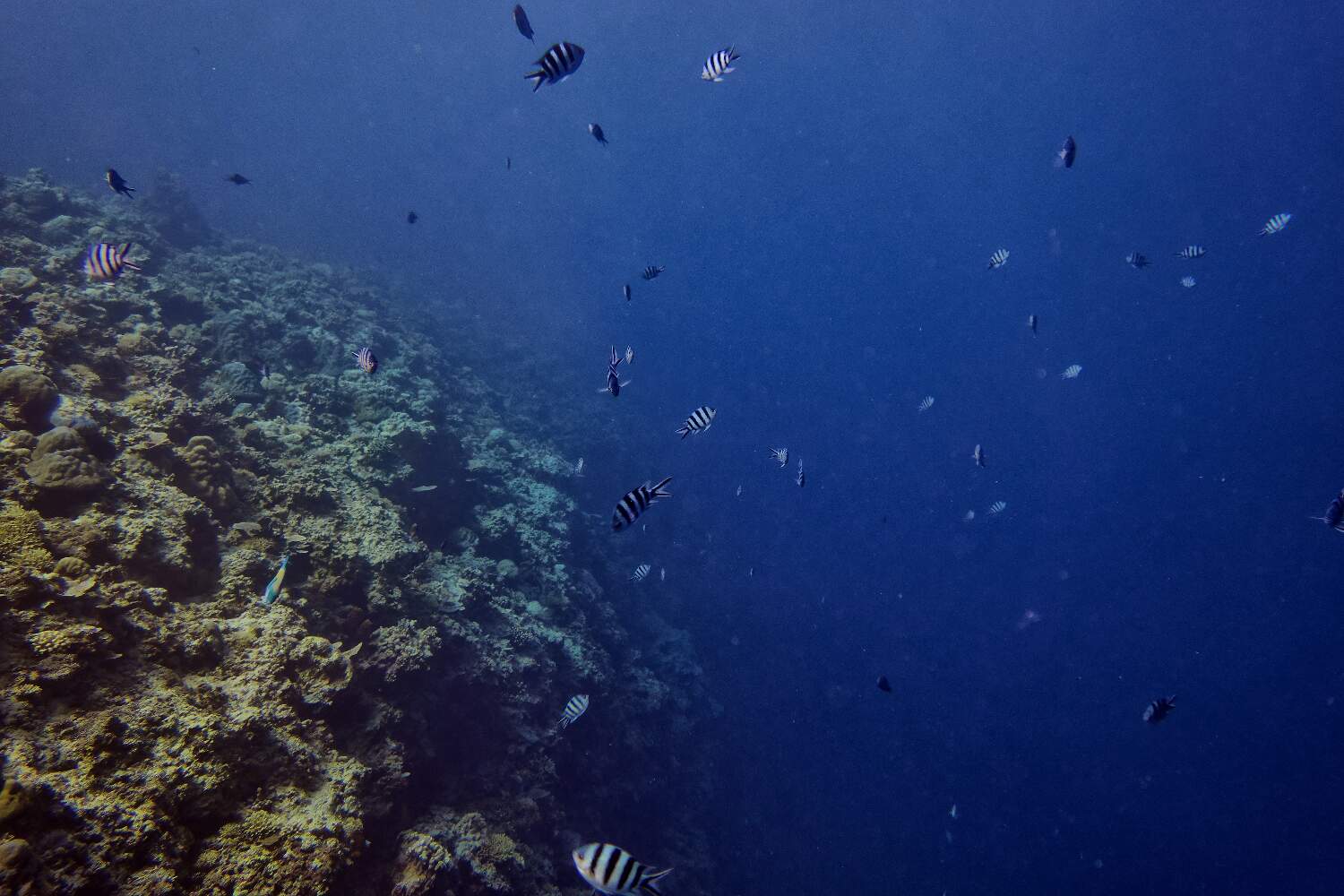
Meno wall
This wall dive is suitable for all levels. Beginners will appreciate the fact that it is protected from strong currents and waves.
Two steep walls go down to 18 metres before gently sloping to the sandy bottom. You can hunt for special marine life in the crevices in the walls, such as spiny lobsters, nudibranchs, multicoloured sea slugs, cowrie shells, porcelain crabs and sea horses. Green turtles shelter in the hollows by the corals, and you will see clownfish, angelfish and anemone fish.
Both Open Water and Advanced Adventure courses can be taken here.
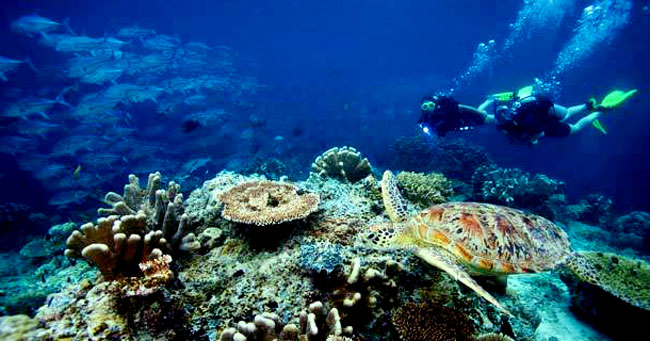
Meno Garden
A perfect location for your first dive, Meno Garden can be found just off the southern tip of Gili Meno. It’s a shallow flat reef with acropora table corals that’s protected from the current, and one of the most beautiful in all of the Gili Islands.
Butterflyfish, triggerfish, trumpetfish and angelfish can be seen here, and larger reef fish can be found at the several cleaning stations along the reef. Manta rays sometimes pass by.

Mirko’s Reef
This is a deep dive site suitable for advanced divers only. It’s a long sea mound that runs along the entire length of Gili Meno. Deep ridges from 18 metres to 35 metres depth are covered with multicoloured sea fans, acropora antler coral, soft corals and sponges.
The beautiful coral reefs are home to trumpetfish, long-nosed butterflyfish, pufferfish, scorpion fish, leaf fish, glass shrimps and porcelain crabs. Blue-spotted ribbon-tailed rays can be seen under coral overhangs, giant frogfish among the sponges and white tipped reef sharks swim the ridges.
To the north of the site is a flat rainbow-coloured reef top 12 metres deep which is home to green turtles.
The depth of the site makes it perfect for the Advanced Adventurer Course and the Deep Specialty Qualification.
How to get to the Gili Meno Dive sites with Bluewater Express
Dive sites in Gili Air
Both Gili Air Divers and Manta Dive Gili Air operate on this island.
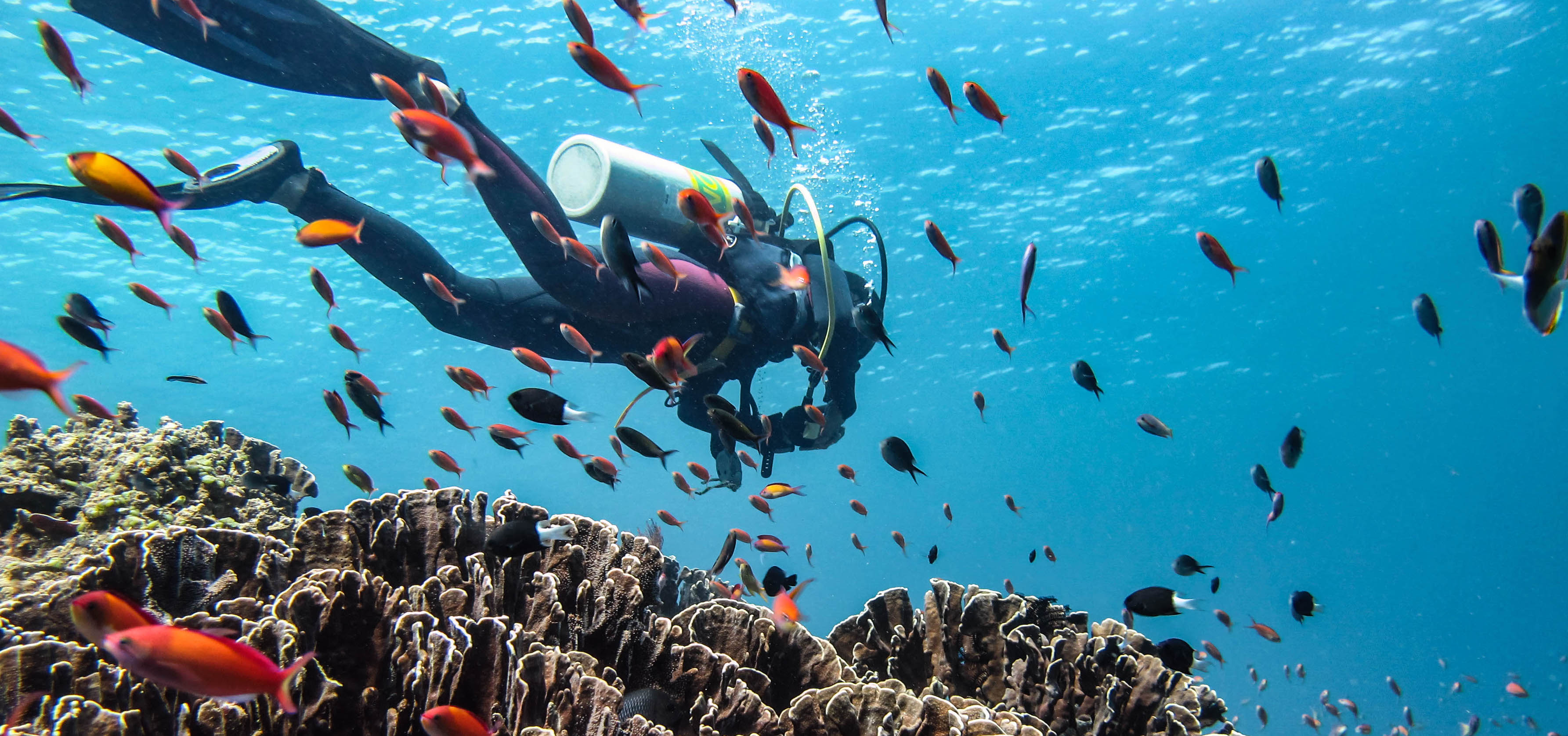
Air Wall
On the south-west side of Gili Air there is a vertical drop from 5 metres to 30 metres in depth. It’s suitable for all levels except absolute beginner, because the currents can be strong here. However, wall dives allow you to choose what depth you descend to and remain at.
At the shallow top of the wall there are soft coral gardens where turtles are found, as well as angelfish, anemone fish, butterflyfish, triggerfish, bump head parrot fish, scorpionfish, leaf fish, wrasse, cleaner shrimp and porcelain crabs.
Down the wall there are sea whips, wire corals, gorgonian sea fans and sponges. Soft corals hang out from the wall into the current. Here you can see wire coral gobies, juvenile sweetlips, pygmy seahorses, banded pipefish, multicoloured nudibranchs, octopuses, painted lobsters, orangutan crabs and wire coral shrimps.
Air Slope
A sandy slope and gentle current make this sheltered spot perfect for beginners to enjoy drift diving.
Hawksbill turtles feed along the slope, blue spotted stingrays can be found in the deeper areas, while among the gorgonian sea fans you will see angelfish, rock mover wrasse, sweetlips, boxfish and nudibranchs.
Han’s Reef

Suitable for all levels of diving ability, this reef is on a gentle sandy slope with a central coral mound surrounded by coral outcrops. Here you will see green turtles, anemonefish, scorpionfish, blue spotted stingrays, octopuses, cuttlefish and peacock mantis shrimp.
If you dive here at night you will find reef squid, bobtail squid, sponge crabs, coconut octopus, dwarf cuttlefish and sea slugs.
Simon’s Reef

This is a deep dive site with overhangs and pinnacles that are home to unique coral species. It’s suitable for advanced divers only.
Among the gorgonian sea fans, sea whips and huge barrel sponges you will see lionfish, scorpion fish, leaf fish, eels, pygmy sea horses, hairy squat lobsters, porcelain crabs, cuttlefish and colourful nudibranchs. Green turtles, spotted eagle rays and white tipped reef sharks swim in the reef canyons.
Taket Malang
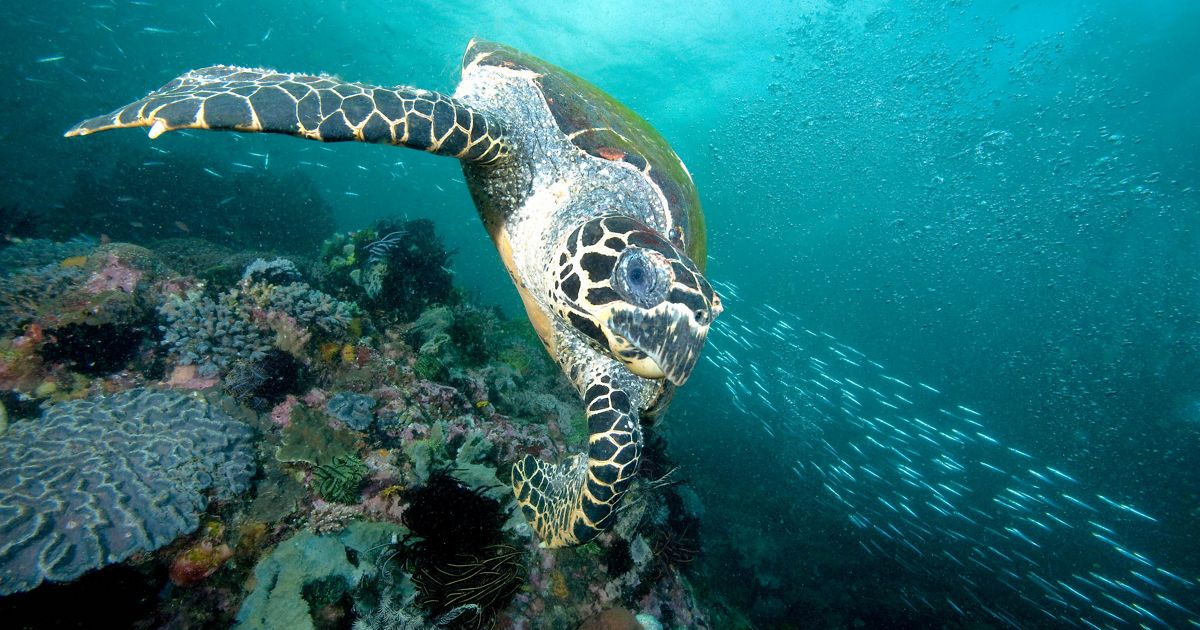
Not suitable for beginners, this intermediate dive site boasts lovely coral gardens below 15 metres of depth.
Hawksbill and green turtles feed in the shallows, while along the deeper ridges amongst rainbow soft corals, barrel sponges and sea fans you will see anemonefish, triggerfish, schooling snappers and fusiliers.
Taket Penyu
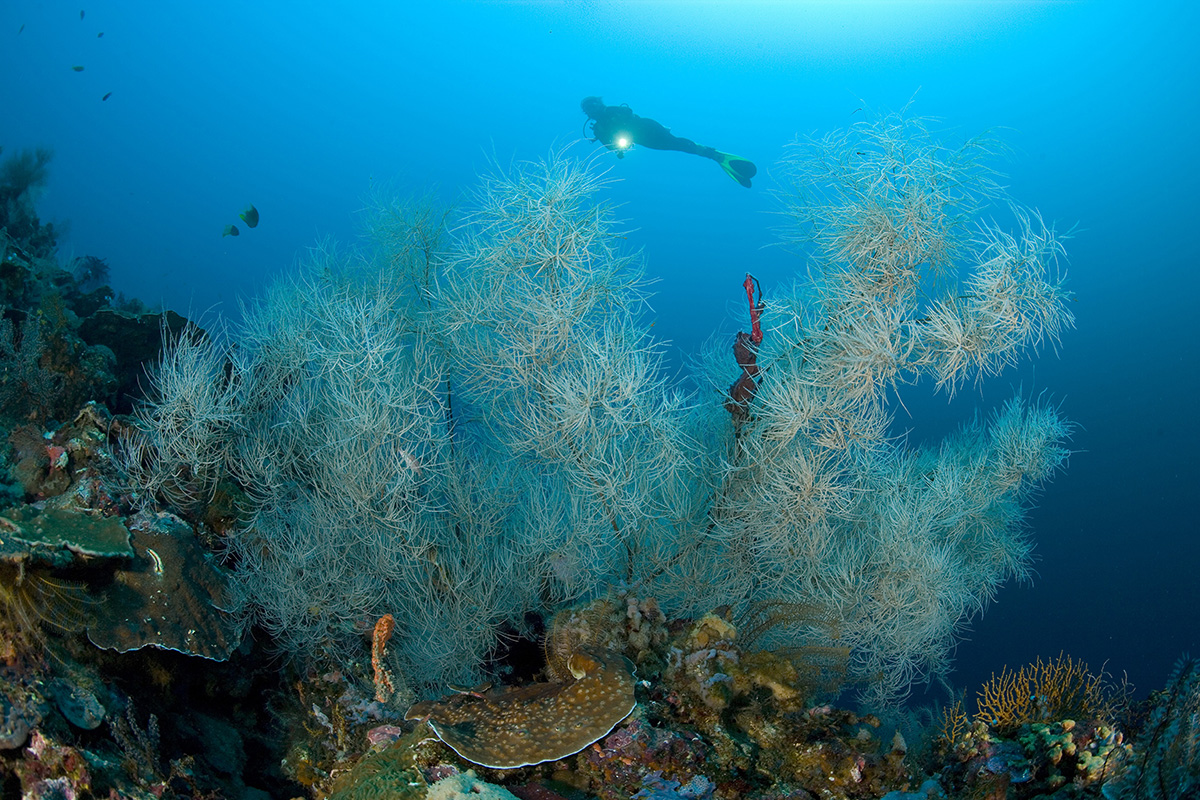
Perfect for beginners, this reef is flat and shallow with gentle slopes on each side, and almost guaranteed turtle sightings.
Among the gorgonian sea fans, sea whips, barrel sponges, anemones and soft corals you will see clownfish, scorpionfish, octopuses, nudibranchs, and mantis shrimps.
The Secret Garden
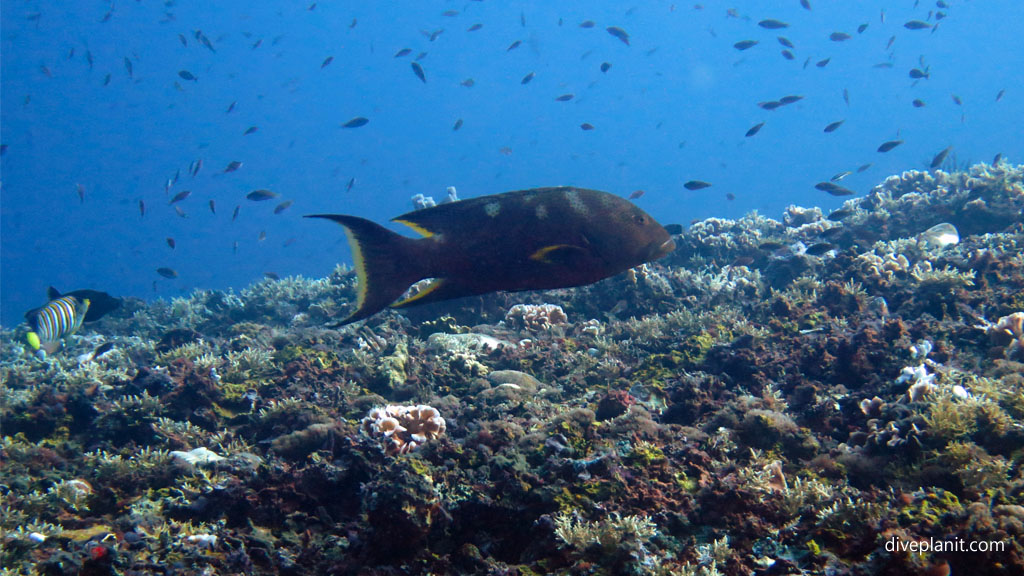
This is a patch reef with a sand and rubble slope, suitable for more advanced divers.
Rare ornate and robust ghost pipefish can be found here, as well as green turtles, scorpionfish, spiny devilfish, anemonefish, blue spotted stingrays, helmut gurnards, blue ribbon eels, frogfish, cuttlefish, octopuses, peacock mantis shrimp and multicoloured nudibranchs.
The Japanese Wreck

This is a deep, advanced decompression dive at a depth of 45m.
There are two World War Two Japanese Patrol ships sunk off the south coast of Gili Air. The wrecks were only discovered recently, and they are now covered with a dense and rich growth of beautiful corals, filled with a wide variety of nudibranchs and hidden groupers.
How to get to Gili Air with Bluewater Express
And finally – why not try muck diving?
With all the beautiful and spectacular coral reefs in pristine, crystal clear waters to choose from, the idea of muck diving in the Gili Islands might seem absurd. But for aficionados, it offers the chance to spot marine life that’s not found elsewhere.

Gili Air Harbour
Constantly in use during the day, the harbor becomes an ideal night diving spot after 5 pm, as it is protected from swell, wind and current. At night you will find seahorses, cockatoo wasp fish, banded pipefish, robust ghost pipefish, harlequin sweetlips and bobtail squid, as well as hawksbill turtles, octopuses, and sponge crabs.
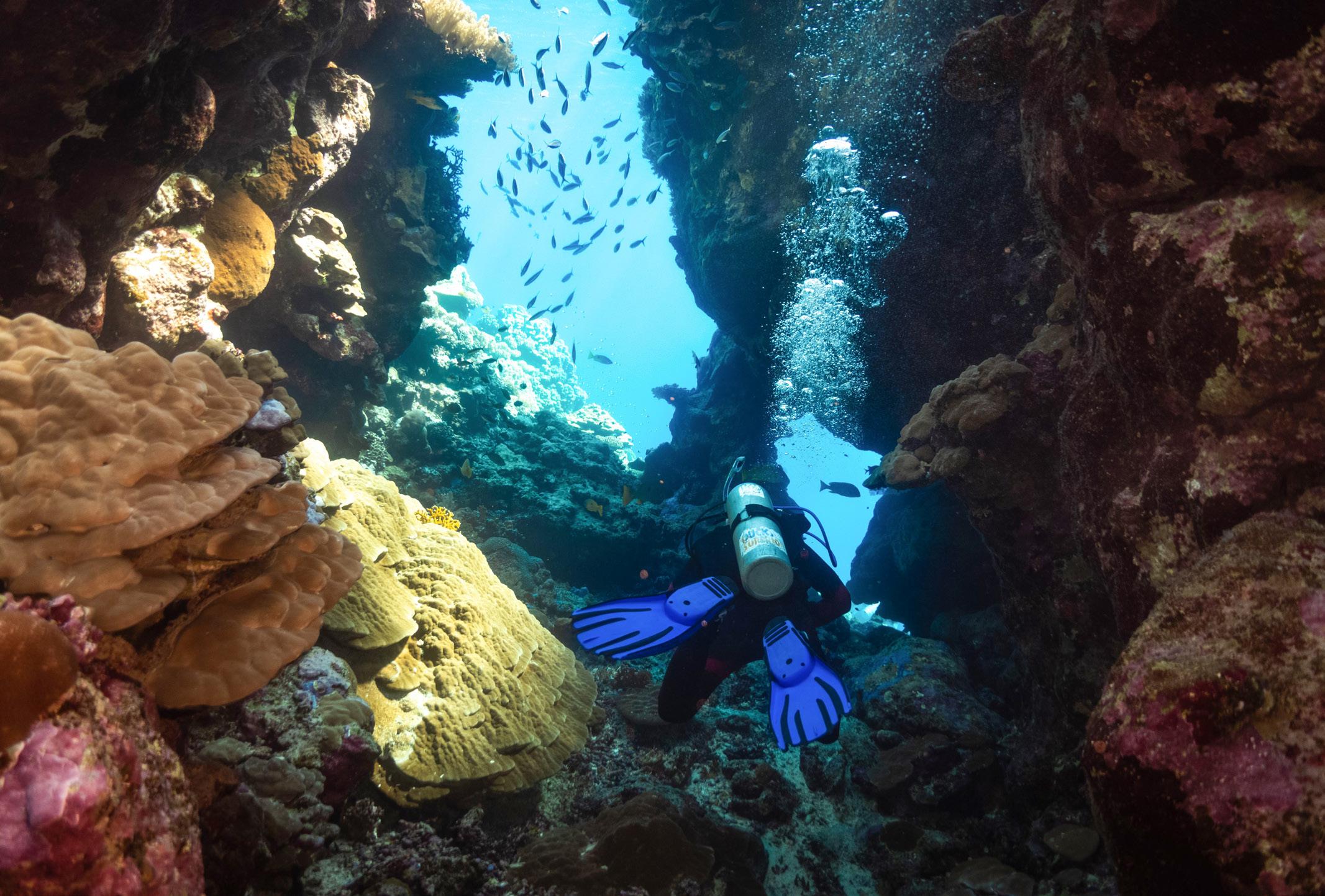
Magic Pier
Suitable for advanced divers only, this dive can feature serious muck, with low visibility. It’s found at Teluk Nara, a boat harbour in West Lombok.
Among the multi-coloured sponges and sea fans you can find mimic octopus, coconut octopus and blue ringed octopus, as well as scorpionfish, painted frogfish, orange striped pipefish, ringed and emperor angelfish, scrawled filefish, pinnate batfish, ribbon eels, decorator crabs, mantis shrimp and nudibranchs.

